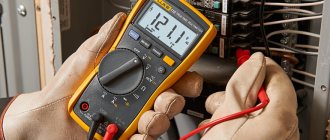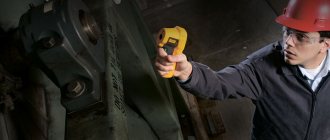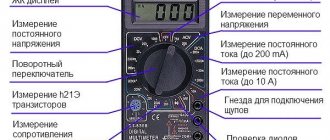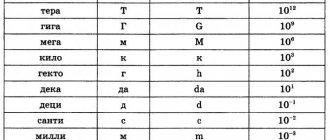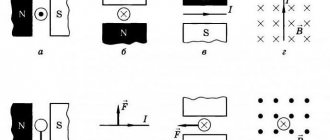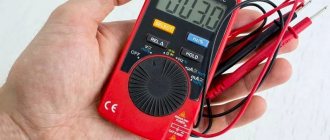What is current and why measure it?
This is the amount of electricity (charge or number of electrons) that moves through the cross section of a conductor in one second. In formulas it is denoted by the capital Latin letter I. The unit of current is Amperes (A).
Current strength is often referred to simply as current. It comes in two types:
- Constant. The current does not change in direction or magnitude. That is, this is a uniform directed movement of charged particles. Formula for calculation: I=Δq/Δt ( Δq(C) is the charge in Coulombs that passed through the cross section; Δt(c) is the time during which the charge passed).
- Variable. This is a current in which even one characteristic changes. It differs at different points in time. To calculate such a current, it is better to use the derivative.
It is generally accepted that a current of 1 A is generated in a conductor with a resistance of 1 ohm if there is a voltage of 1 V.
Checking the current with a multimeter is needed for:
- Clarification of the actual power consumption of the electrical unit.
- Detecting defects in electrical devices if its power is less than that declared by the manufacturer.
- Determination of the electrical capacity of autonomous energy sources, for example, batteries.
- Detection of current leakage in electrical circuits.
Ammeters are often used to determine current or amperage. But, if you have a multimeter with this function, feel free to use it.
Here's a video on how to measure current with a multimeter:
Wiring type and its parameters
At home, you most often have to deal with alternating current, much less often with direct current. Typically, direct current is measured in batteries and batteries; house wiring always runs on alternating current. Even if the electrical network is powered by batteries (a backup power source, the main one in the absence of a centralized power supply), it must contain an “adapter” - a device that converts direct current into alternating current.
When figuring out how to measure current with a multimeter, you need to clearly understand: to work with direct current, use the DCA (A-) segment of the multimeter, for measuring alternating current, use the ACA (A~) sector. The designations are associated with abbreviations of English terms: direct current amperage (DCA) and alternating current amperage (ACA) is the designation of alternating current on a multimeter.
Typically, multimeters allow you to measure microcurrents - up to 200 mA - and stronger ones (up to 10A). Devices that allow measurements in more powerful electrical networks have an additional socket for a plug (probe) marked 20A. Typically, in models with four connectors, two are designed to measure current in different ranges, one is for other measurements (voltage, resistance).
The COM (COMMON) connector, common (universal) for all types of measurements, is intended for the negative (black) probe of the multimeter.
Thus, to measure current with a multimeter, you need to connect the black probe to the COM connector, and the red probe to the socket for checking microcurrents or ordinary currents. For sockets and switches, the device regulator is set to the alternating voltage sector, for batteries and batteries - constant. If the level is unknown in advance, the highest value allowed by the device is selected.
Important: if no energy-consuming device is connected to the outlet (on the switch), the electrical circuit is open and there is no current in it!!! Measuring the current directly in the socket or on the contacts of the switch is useless and dangerous! This causes a short circuit.
Principles of measuring current with a multimeter
Measuring current with a multimeter is not difficult, but there are certain rules that should not be neglected:
- The electrical network must be de-energized.
- Cables must be well insulated, otherwise the risk of electric shock increases.
- Operate the meter wearing gloves that do not conduct electricity, such as rubber.
- Do not try to determine the current when there is high humidity, because this also increases the risk of electric shock.
- Measure quickly so that the probes do not connect to the wires for more than 1-2 seconds. This is especially important if you are going to work with low-power elements. For example, if you use a multimeter to measure the battery current and hold the probes for a long time, they will be completely or partially discharged.
We recommend that you carry out all electrical work with a partner who will provide first aid/call an ambulance if an emergency occurs.
Preparing to measure voltage
In some cases, the voltage is checked. For example, consider a computer power supply. Remove the side cover of the system box. Then disconnect all the cables going to the power source.
The bundles are assembled from conductors of different colors, each of them corresponds to a certain voltage. Contacts with black wires correspond to common (ground). The yellow conductor supplies +12 volts, red +5 volts, orange +3.3 volts. Blue corresponds to -12 V, white -5 V, purple +5VSB (standby power), gray PW-OK (Power good), green PS-ON.
When the switch is on, there should be +5 V on the PS-ON and PW-OK contacts.
The purple wire has voltage as long as the power switch on the back of the computer is turned on and plugged in. This allows you to start your computer remotely.
White is rarely used, intended for expansion cards installed in the ISA slot.
The blue wire is required for the RS232, FireWire and some PCI expansion cards.
How to measure current with a multimeter: main points
All types of current are measured using different methods inside the measuring device. Therefore, the tester always has an element with which the desired mode and range are set. In more advanced models, the range is determined automatically.
To select a mode, you usually only need to turn the knob to one of the following values:
- Direct current: A -, DCA, I -;
- Variable: A ~, ACA, I ~;
We strongly advise you to read the instructions for the multimeter, which contain the symbols available on the tester. They may vary depending on the model. An article on how to use a multimeter will also be useful.
Please note that to measure current with a multimeter you will have to create an open circuit! This is the main difference between this test and measuring, for example, voltage, when the multimeter should be connected to the circuit in a parallel circuit.
Masters break the circuit under test in different ways. To include a limiting resistance in the circuit, resistors are also used, but most often ordinary light bulbs.
Please note that breaking the electrical circuit must be done before starting measurements with the voltage turned off!
Measurement order
A multimeter for measuring current is connected to an open circuit. This is the main difference from the voltage measurement procedure, in which the tester is connected to the circuit in parallel. The indicator of the amount of current that passes through the device is displayed by an arrow on the scale (if we are talking about an analog device) or is displayed on the liquid crystal (LED) display.
There are different ways to break the circuit under test to connect the device to it. For example, by disconnecting one of the terminals of the radio element using a soldering iron.
Sometimes you have to cut the wire with wire cutters or pliers.
When determining the current value of a battery or accumulator, such a problem does not exist, since a circuit is simply assembled, one of the elements of which is a multimeter.
How to measure direct current with a multimeter
Batteries and accumulators are most often checked; they are constant sources.
In how to measure amperes with a multimeter, it is important to select the appropriate function on the device, as well as connect the tester in the correct polarity: red cable to positive power, black to negative. If the probes are mixed up, the display will show negative numbers.
Also, regarding how to measure current with a multimeter, you need to understand what signal level will be tested. If the circuit contains milliamps, the red cable is connected to the hole on the multimeter where VΩmA is indicated or a certain range is written. If you are examining a power circuit where the Amps are, connect to the one labeled A or NA (usually 5-10 A here). Again, we advise you to carefully study the instructions for the multimeter. If you mess something up at this stage, the multimeter may break.
Instructions for measuring DC current with a multimeter:
- We arrange the probes.
- Select the DC function.
- If necessary, set the signal level (set it higher than what you expect).
- We connect the tester into a break in the chain of the circuit branch, not forgetting to observe the polarity.
- Turn on the energy source.
If there are no values, the range is most likely selected incorrectly. Try lowering it until you see a reading.
See how to measure amperes with a multimeter:
How to measure amperage with a battery-powered multimeter
It is a simple portable power source and does not require the application of a load. Apart from this, the remaining steps are the same: select the desired function on the multimeter, arrange the probes in accordance with the polarity.
What the readings may indicate:
- 4-6 A - everything is fine.
- Below four - the battery is only suitable for use in low-power devices.
- Below 2.5 A - this battery is asking for trash.
Compare the readings with those written on the batteries.
Watch a useful video on how to measure battery amperes with a multimeter:
How to check the current of a battery with a multimeter
The rule here is with a load element, which can be a simple incandescent light bulb. Most likely, its resistance will be no more than several hundred Ohms. How to check the load with a multimeter? Tester, selecting the desired mode. For example, read more about checking resistance with a multimeter here.
Then use this formula: I = U / R (I - current A, U - battery voltage, R - light bulb resistance).
Compare the numbers you get when measuring the current with a multimeter with the resulting value. If you see a difference, especially a significant one, it may be a bad charge.
Useful video on how to check amperes with a multimeter:
Voltage determination
DC and AC voltage values can also be found using a multimeter. To do this you need:
- Connect the red wire with the measuring probe to the input of the device marked V Ω mA, the black wire must be left in the socket marked COM;
- Use the measuring device regulator to select the DC or AC voltage test mode (depending on the characteristics of the circuit);
- If required, select the level of the signal being tested;
- Connect the probes to the circuit parallel to the area where you want to measure the voltage;
- The required value will be displayed on the multimeter screen.
A multimeter is an indispensable device for effectively working with electrical circuits and signals. Using such a device, you can quickly identify a malfunction and determine the necessary signal parameters, so it is important to always have it on hand.
How to measure alternating current with a multimeter
It happens that you need to check the electrical network, for example, for a house with several apartments. If you can measure the AC current, it will help you make proper wiring repairs.
And again you cannot do without a load, and again a light bulb can play its role.
Instructions on how to measure alternating current with a multimeter:
- We connect the wires to the required holes on the multimeter.
- Select the desired measurement function on the multimeter and, if necessary, the signal strength.
- We connect the selected load element in series with the meter to the socket.
- Let's look at the readings. The light starts to burn.
You learned how to measure current with a multimeter.
We wish you safe and accurate measurements!
Types of Multimeters
All devices, according to their design and principle of measuring current indicators, can be divided into two types:
- Analog testers.
- Digital multimeters.
Briefly about each type of measuring device.
Analog multimeters
The main difference between analog and digital devices is the presence of a digitized scale with an arrow. They are very easy to use and quite cheap. But their disadvantage is considered to be the presence of errors in the readings. Although this can be corrected using a tuning resistor. But, all the same, it is unlikely that it will be possible to achieve accuracy comparable to digital instruments. And in some cases, this is really necessary.
Digital multimeters
Since the presence of a scale with an arrow is mentioned as one of the main differences between analog devices, it is logical to assume that they are absent in digital devices. And indeed it is. The measurement results are displayed on the display, which can be LED or liquid crystal, in the form of specific numbers.
As already mentioned, the main advantage of digital testers is the accuracy of current measurement. In addition, they are not much more difficult to use than analog ones. Even a beginner can cope with measurements after a short instruction. The downside is the higher cost of a digital device.

